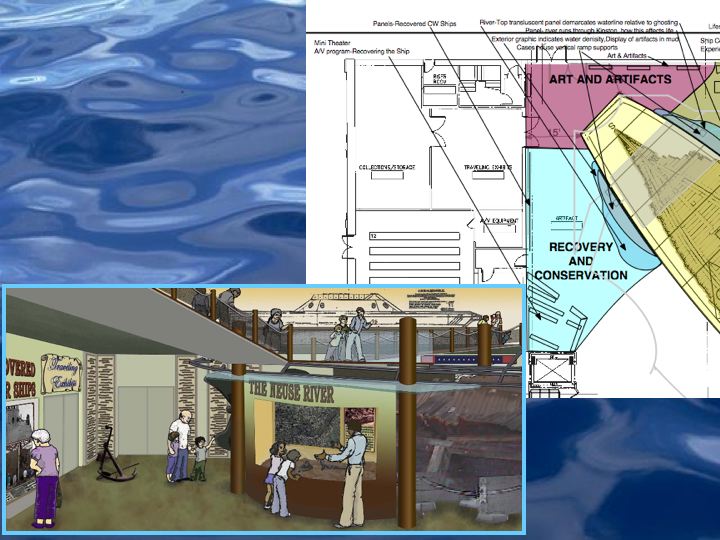CSS NEUSE MUSEUM, Kinston, North Carolina, USA
The North Carolina Department of Cultural Resources is guardian of the Civil War gunship CSS NEUSE relic. The State has allocated resources to create a new home for the ship in Kinston, North Carolina. Ph Group is part of the team directed by Dunn & Dalton Architects to produce the new museum. The exhibits are currently in schematic design phase.
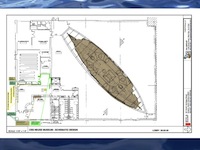 The exhibits within the Museum are designed to be divided into a series of zones, each zone covers a complete subject while touching upon and adding to material from other zones. There is a preferred path through the exhibits: starting in the Lobby, clockwise around the Second Floor from the elevator, then clockwise around the Ground Floor. The exhibits are also designed so large groups such as schools can be circulated throughout the zones so as the experience the entire exhibit presentation.
The exhibits within the Museum are designed to be divided into a series of zones, each zone covers a complete subject while touching upon and adding to material from other zones. There is a preferred path through the exhibits: starting in the Lobby, clockwise around the Second Floor from the elevator, then clockwise around the Ground Floor. The exhibits are also designed so large groups such as schools can be circulated throughout the zones so as the experience the entire exhibit presentation.
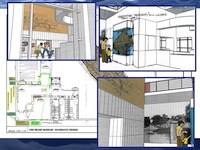 While waiting to begin their tour, Visitors in the Lobby can examine up close a section of the ship's remains. The Lobby also accesses a Theater, over the door of the Theater a mural illustrates action inside the ship's gundeck. An elevator provides access to theExhibit Areas, the doors open from the center of a wall size photograph of 1860's Kinston, so that the Visitor steps through the portal, transistioning back in time to the era of the CSS Nuese.
While waiting to begin their tour, Visitors in the Lobby can examine up close a section of the ship's remains. The Lobby also accesses a Theater, over the door of the Theater a mural illustrates action inside the ship's gundeck. An elevator provides access to theExhibit Areas, the doors open from the center of a wall size photograph of 1860's Kinston, so that the Visitor steps through the portal, transistioning back in time to the era of the CSS Nuese.
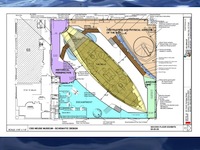
The museum tour begins on the second floor. The first major exhibit is the ship’s relic, below a hanging steel framework which outlines her original shape. The Visitor has the opportunity to follow a ramp to stand at deck level of the ship, to appreciate a unique historical perspective of the relic and framework..
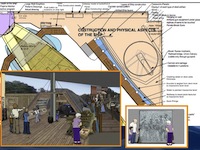 Continuing around the mezzanine, the Visitor encounters a FULL SCALE INTERACTIVE ENVIRONMENT of the ship’s gundeck, including a working simulation of the cannon, artifacts and hands-on replica. The multi-layer construction method is demonstrated around the exhibit’s edge, next to a portion of the relic’s hull for comparison. Adjacent areas display the Museum’s ordinance collection. The environment includes a background mural of the Neuse River and woods. The dock walkway leads to the Kinston Area exhibits.
Continuing around the mezzanine, the Visitor encounters a FULL SCALE INTERACTIVE ENVIRONMENT of the ship’s gundeck, including a working simulation of the cannon, artifacts and hands-on replica. The multi-layer construction method is demonstrated around the exhibit’s edge, next to a portion of the relic’s hull for comparison. Adjacent areas display the Museum’s ordinance collection. The environment includes a background mural of the Neuse River and woods. The dock walkway leads to the Kinston Area exhibits.
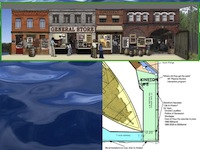 The KINSTON area period building facades present information about the effects of the War on the population, including shortages, politics of secession, and blockade running. Some windows will be used as artifact cases, others for interactive displays. Murals inside windows and door opening provide glimpses of period life. In Design Development phase, actual period buildings from Kinston will be researched so that these facades can be built to resemble the 1860’s locale.
The KINSTON area period building facades present information about the effects of the War on the population, including shortages, politics of secession, and blockade running. Some windows will be used as artifact cases, others for interactive displays. Murals inside windows and door opening provide glimpses of period life. In Design Development phase, actual period buildings from Kinston will be researched so that these facades can be built to resemble the 1860’s locale.
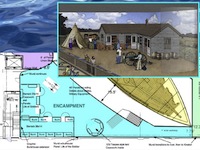 The ENCAMPMENT area presents topics revolving around the life of the Civil War soldier. Two full scale barracks allow for interactive living environments as well as informational displays and artifact presentation. A full scale Sibley tent demonstrates information about soldiers’ life in the field. On the background mural, sanitation and other requirements for housing large numbers of people are discussed. Along the railing, panels and artifacts present detailed information about local battles and military equipment.
The ENCAMPMENT area presents topics revolving around the life of the Civil War soldier. Two full scale barracks allow for interactive living environments as well as informational displays and artifact presentation. A full scale Sibley tent demonstrates information about soldiers’ life in the field. On the background mural, sanitation and other requirements for housing large numbers of people are discussed. Along the railing, panels and artifacts present detailed information about local battles and military equipment.
The central open area has been created for supervised group activities.The ENCAMPMENT area presents topics revolving around the life of the Civil War soldier. Two full scale barracks allow for interactive living environments as well as informational displays and artifact presentation. A full scale Sibley tent demonstrates information about soldiers’ life in the field. On the background mural, sanitation and other requirements for housing large numbers of people are discussed. Along the railing, panels and artifacts present detailed information about local battles and military equipment. The central open area has been created for supervised group activities.
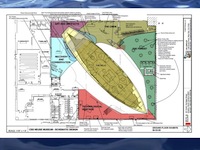 The recovery of the relic and conservation efforts to preserve the CSS Neuse are discussed on the ground floor.
The recovery of the relic and conservation efforts to preserve the CSS Neuse are discussed on the ground floor.
 To enhance this information, an exhibit about the water qualities and other physical aspects of the Neuse River assists the Visitor in understanding how the ship survived until present day. Faux artifacts buried in mud can be “discovered” by Visitors.This exhibit about the RIVER is topped with a translucent panel which illustrates the waterline of the ship for the GHOSTING and DECK EXPERIENCE. A second RIVER exhibit on the other side of the ship, near the CREW area, talks about how the river and other waterways affected the life of the community and the War. The two River exhibits house the vertical supports for the DECK EXPERIENCE platform.
To enhance this information, an exhibit about the water qualities and other physical aspects of the Neuse River assists the Visitor in understanding how the ship survived until present day. Faux artifacts buried in mud can be “discovered” by Visitors.This exhibit about the RIVER is topped with a translucent panel which illustrates the waterline of the ship for the GHOSTING and DECK EXPERIENCE. A second RIVER exhibit on the other side of the ship, near the CREW area, talks about how the river and other waterways affected the life of the community and the War. The two River exhibits house the vertical supports for the DECK EXPERIENCE platform.
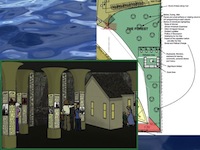 Like a forest is made up of great numbers of individual trees, so is the story of the life of the CSS Neuse and the Civil War made up of countless lives, each with a unique experience and perspective. To present topics such as the Life of Women, the African-American Experience, the Experience of Immigrant Groups, the Politics of Secession, Divided Loyalties, the impact of mobilizing for war, Before And After the war, social, economic and political change, the Forest area is made up of a number of individual exhibits, each telling the story of a single person or family.
Like a forest is made up of great numbers of individual trees, so is the story of the life of the CSS Neuse and the Civil War made up of countless lives, each with a unique experience and perspective. To present topics such as the Life of Women, the African-American Experience, the Experience of Immigrant Groups, the Politics of Secession, Divided Loyalties, the impact of mobilizing for war, Before And After the war, social, economic and political change, the Forest area is made up of a number of individual exhibits, each telling the story of a single person or family.
These stories will be carefully chosen to highlight the topics. Ideally, each story will be based upon local residents of Kinston and Lenoir County so that when Visitors from the local area come to the Museum, they see their families, and themselves, reflected within the walls of the Museum. Physically, the exhibit is a number of “trees”, each of which is a pillar whose center section can be rotated. This section is three sided, with each side telling the story of the subject BEFORE, DURING and AFTER the War.

